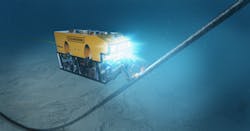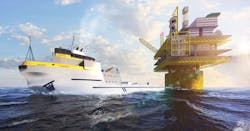New method for steel catenary riser decommissioning reduces disruption to topsides operations
Ansel Orr, Oceaneering, and Nagu Tatineni, Williams
According to analysts, aging platforms have been decommissioned at the rate of 130 per year for the past 10 years, with asset removals outnumbering the new installations being commissioned. This trend is likely to continue in the US given that more than 40% of the approximately 3,700 active platforms on the outer continental shelf are more than 25 years old. The decommissioning process is costly and time consuming, and with so many decommissioning projects on the horizon, owners are looking for faster and easier ways to safely remove aging structures.
Finding a better option
Decommissioning is a multifaceted operation that can be carried out in several ways. In the Gulf of Mexico (GoM), a small number of platforms that meet the requirements for the National Artificial Reef Plan have been toppled in place or towed to approved artificial reef sites, where they could be placed on the seabed. For most assets, however, the process is more time-consuming, labor-intensive, complicated, and costly, especially when the decommissioning process includes removing steel catenary risers (SCRs).
Traditionally, SCR decommissioning is carried out by installing a topside winch package to control the riser during removal. When this process is followed, the winch is delivered to the platform, where other equipment often must be removed from the topside to accommodate it. After structural engineering checks are performed to ensure the winch is stable on the platform, engineers determine where to create drop points through the platform to make sure the winch is stabilized so it can safely manage the weight of the disconnected riser while transferring it to a heavy lift vessel for abandonment.
When the Sir Douglas Morpeth Tension Leg Platform (TLP) ceased production in 2018, Williams was responsible for decommissioning the 22-year-old, 8-in. gas export SCR on the structure. At the time of the decommissioning, Morpeth, the world’s first SeaStar 1 Mini-TLP, was operating in 1,700 ft (518 m) water depth on Ewing Bank block 921 offshore Louisiana.
Williams was aware that a supermajor had successfully followed a different approach in the GoM to remove a riser to make space for a new one. The method employed a multi-service vessel (MSV) fitted with a winch instead of placing a winch on the topsides. The pipeline company approached Oceaneering with a request to evaluate the application of this new method to remove the SCR on the Morpeth TLP.
Preparing for execution
Executing this method of SCR removal had been proven but applying it to remove the Morpeth SCR was not without challenges.
The engineering team needed a thorough understanding of the riser and the TLP, but Williams did not have the as-built engineering drawings used by the private company that had previously owned and installed the pipeline. That left a significant “unknown.” Without the drawings, the team did not know for sure the actual position of the SCR in relation to the SCR porch, topsides, and touchdown point.
Oceaneering reverse engineered a solution by creating its own model. Deploying an ROV to survey the SCR, it was possible to gather detailed as-found information to pinpoint the riser position by meshing the new data with content of the 22-year-old installation drawings that were available.
A second challenge with the Morpeth SCR removal was the riser location. Removal would have to be precisely managed to avoid clashing between the riser being removed and a 12-in. oil export riser located 18 ft (5.5 m) away that still contained hydrocarbons.
Finally, the 8-in. gas export riser being taken out of service had to be pigged and flushed before being cut and capped to ensure there were no hydrocarbons remaining in the line that could potentially escape into the environment.
Using all the data available, the engineering team used OrcaFlex to model the riser motions as well as the motions of the MSV that would be used in the riser removal process to predict how they would react when the riser was cut. The information generated allowed the team to determine the optimal orientation of the vessel, the appropriate distance from the TLP, the best point at which to cut the riser, and the best place to attach the clamp to minimize the dynamic swing of the riser. The model enabled the engineers to predict how the vessel and riser would react as well as the anticipated behavior of the piece of the riser that would remain connected to the asset.
Using the modeling tool, the team determined that a winch wire could be cantilevered off the stern of the MSV to provide overhead access to the riser and clamp connection point, ensuring that when the SCR was cut it would not swing out and clash with the vessel.
Putting the solution to work
With a good understanding of the dynamics of the operation, the team was ready to begin. After the pipeline was successfully pigged and flushed, arrangements were made for Oceaneering’s Ocean Patriot dive support vessel and its saturation divers to remove marine growth and insulation from the area of the SCR where the clamp would be installed prior to riser removal.
When the SCR was ready, the Louisiana-based Otto Candies vessel Ross Candies, fitted with a winch rated for the anticipated weight of the riser, moved into place to connect to the riser in preparation for cutting it and placing it on the seafloor once it was disconnected from the TLP.
When all the components were in place, the winch line was clamped onto the SCR; an ROV was deployed to sever the riser above the clamp. When the riser was cut at the prepared location, it swung away from the vessel. A secondary cut disconnected the riser from the 21-mi (34-km) pipeline, allowing the MSV to abandon the riser portion within the predetermined right-of-way corridor of the pipeline, where it was plugged, and the ends of the SCR covered with concrete mats.
Measuring the actual dynamic loads during the operation confirmed the accuracy of the OrcaFlex model, showing exceptional agreement, with modeled loads within 5% of the actual loads, which measured approximately 54 metric tons.
This unconventional method of SCR removal enabled the project to be executed entirely from the MSV at a lower cost than the traditional method and without compromising operational safety. An added benefit is that the riser decommissioning took place without disrupting work being carried out on the topsides or negatively impacting the operator’s decommissioning schedule.
Building on success
With the experience gained during the first SCR project, Williams immediately began planning for the next work program, requesting a FEED to use this integrated decommissioning solution on additional offshore assets in the GoM. The only change anticipated for the upcoming decommissioning programs is a redesign of the clamp that will allow it to be installed by an ROV. The new three-year study includes abandonment programs for five SCRs with loads greater than 350 metric tons on multiple TLPs.
The successful execution of this vessel-based SCR decommissioning project lays the groundwork for future applications, including existing riser replacement, abandonment or recovery of flushed umbilicals, and abandonment of flexible catenary risers.
Acknowledgment
This article is a synopsis of paper OTC-31029-MS, “Unconventional Approach Simplifies Steel Catenary Riser Decommissioning,” presented at the Offshore Technology Conference held in Houston, Texas, Aug. 16-19, 2021. The authors wish to thank SPE for permission to rewrite the technical paper for publication.

